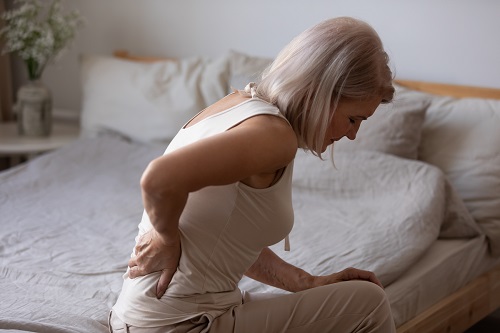
09 Sep How Osteoporosis Is Diagnosed and Treated Early in Women
Osteoporosis causes bones to become weak, raising the chance of fractures, especially in women as they age. Detecting and treating osteoporosis early helps protect bone strength and reduce this risk. Here is more information on how doctors diagnose osteoporosis, lifestyle changes that support bone health, and common treatments that can slow or manage the condition:
Diagnosing Osteoporosis
Doctors rely on a bone mineral density (BMD) test to diagnose osteoporosis. The most widely used BMD test is called a dual-energy X-ray absorptiometry, or DXA scan. This simple, non-invasive scan uses low-dose X-rays to measure the density of your bones, typically in the spine, hip, or forearm. The scan results come as a T-score, which shows how your bone density compares to that of a healthy young adult. Doctors use this score to determine if osteoporosis is present.
Diagnosis involves more than just a scan. Doctors also collect your medical history, ask about your family’s history of osteoporosis, and check for any lifestyle habits that may affect your bones. In some cases, you may need blood or urine tests to look for other causes of bone loss, like low vitamin D or thyroid problems. This full review helps create a clear picture of your bone health and risk factors.
Adapting Lifestyle Factors
Daily habits play a role in keeping bones strong. Exercise is a key part of any plan for healthy bones. Weight-bearing activities, such as walking, jogging, or dancing, make your bones work against gravity, which helps them stay strong. Muscle-strengthening exercises, such as lifting weights or using resistance bands, also support bone density and balance.
What you eat is a factor in bone health. Getting enough calcium and vitamin D builds and protects bone tissue. Dairy foods, dark green leafy vegetables, and foods with added calcium are good choices. Vitamin D comes from certain foods, like fatty fish or fortified milk, and from sunlight. Following these nutrition tips supports strong bones at every age.
Exploring Treatment Options
When exercise and nutrition alone do not keep bones strong, doctors might suggest medication. Different types of medicine can slow bone loss or help build new bone. Bisphosphonates are commonly used, available as tablets or through an IV. They work by slowing down cells that break down bone, helping bones stay denser.
For some women, particularly after menopause, hormone-based therapies can help manage osteoporosis. Estrogen therapy helps maintain bone density, and selective estrogen receptor modulators (SERMs) offer similar benefits with fewer risks. Treatments called anabolic agents encourage the body to form new bone. Doctors select medication based on your health needs, age, and risk factors.
Learn More About Osteoporosis
Early diagnosis and ongoing management make a difference in protecting bone health for women. Doctors use DXA scans, medical history, and lab tests to spot osteoporosis early. Making exercise and healthy eating part of your routine helps keep bones strong. When needed, medications can slow bone loss or build new bone tissue. Together, these steps offer a practical approach to supporting bone health and lowering the risk of fractures. If you’re experiencing symptoms of this condition, consult with a qualified specialist to learn more.

No Comments